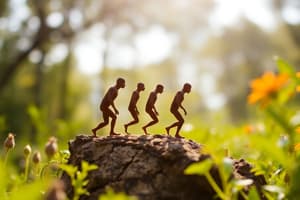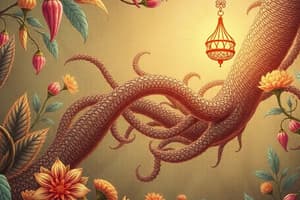Podcast
Questions and Answers
What does the cell theory state?
What does the cell theory state?
- All living organisms are composed of cells. (correct)
- All cells have a nucleus.
- Cells are not important for life.
- Cells are only found in animals.
Which molecule encodes hereditary information?
Which molecule encodes hereditary information?
- Carbohydrate
- Lipid
- DNA (correct)
- Protein
What process explains how populations of organisms change over time?
What process explains how populations of organisms change over time?
- Homeostasis
- Thermodynamics
- Evolution (correct)
- Cell Theory
Maintaining a stable internal environment is known as what?
Maintaining a stable internal environment is known as what?
What is the basic unit of life?
What is the basic unit of life?
Which of these options describes a group of similar cells performing a specific function?
Which of these options describes a group of similar cells performing a specific function?
Which of these options describes an organelle found in eukaryotic cells?
Which of these options describes an organelle found in eukaryotic cells?
What is the function of ribosomes?
What is the function of ribosomes?
What is the process of copying DNA into RNA called?
What is the process of copying DNA into RNA called?
What cellular structures are the sites of photosynthesis in plants?
What cellular structures are the sites of photosynthesis in plants?
What is the term for traits that enhance an organism's survival and reproduction?
What is the term for traits that enhance an organism's survival and reproduction?
Which of the following is a group of individuals of the same species living in the same area?
Which of the following is a group of individuals of the same species living in the same area?
What is the study of microorganisms called?
What is the study of microorganisms called?
What is the process by which new species arise?
What is the process by which new species arise?
Which kingdom do animals belong to?
Which kingdom do animals belong to?
What type of organism obtains food by consuming other organisms?
What type of organism obtains food by consuming other organisms?
What are changes in the DNA sequence called?
What are changes in the DNA sequence called?
Which of the following is a non-cellular entity that requires a host to replicate?
Which of the following is a non-cellular entity that requires a host to replicate?
Flashcards
Biology
Biology
The scientific study of life.
Cell Theory
Cell Theory
All living organisms are composed of cells.
Gene Theory
Gene Theory
Hereditary information is encoded in DNA and passed from parents to offspring.
Evolution
Evolution
Signup and view all the flashcards
Homeostasis
Homeostasis
Signup and view all the flashcards
Thermodynamics
Thermodynamics
Signup and view all the flashcards
Cells
Cells
Signup and view all the flashcards
Genes
Genes
Signup and view all the flashcards
Transcription
Transcription
Signup and view all the flashcards
Translation
Translation
Signup and view all the flashcards
Mutations
Mutations
Signup and view all the flashcards
Natural Selection
Natural Selection
Signup and view all the flashcards
Adaptations
Adaptations
Signup and view all the flashcards
Populations
Populations
Signup and view all the flashcards
Biomes
Biomes
Signup and view all the flashcards
Biodiversity
Biodiversity
Signup and view all the flashcards
Study Notes
- Biology is the scientific study of life.
Core Principles of Biology
- Cell theory: All living organisms are composed of cells.
- Gene theory: Hereditary information is encoded in DNA and passed from parents to offspring.
- Evolution: Populations of organisms change over time through natural selection.
- Homeostasis: Living organisms maintain a stable internal environment.
- Thermodynamics: Life depends on the flow and exchange of energy and matter.
Levels of Biological Organization
- Molecules: Atoms combine to form molecules, such as DNA and proteins.
- Cells: The basic unit of life, consisting of organelles and other structures enclosed by a membrane.
- Tissues: Groups of similar cells performing a specific function.
- Organs: Structures composed of different tissues working together.
- Organ Systems: Groups of organs that cooperate to perform major bodily functions.
- Organisms: Individual living beings composed of organ systems.
- Populations: Groups of individuals of the same species living in the same area.
- Communities: Populations of different species interacting with each other.
- Ecosystems: Communities interacting with their physical environment.
- Biosphere: The part of Earth inhabited by living organisms.
Cell Structure and Function
- Cells are the basic units of life.
- Prokaryotic cells lack a nucleus and other membrane-bound organelles.
- Eukaryotic cells have a nucleus and other membrane-bound organelles.
- The plasma membrane is a selectively permeable barrier that controls the movement of substances into and out of the cell.
- The nucleus contains the cell's genetic material in the form of DNA.
- Ribosomes are responsible for protein synthesis.
- The endoplasmic reticulum (ER) is involved in protein and lipid synthesis.
- The Golgi apparatus modifies, sorts, and packages proteins and lipids.
- Mitochondria are responsible for cellular respiration and energy production.
- Lysosomes contain enzymes for breaking down cellular waste.
- Cytoskeleton provides structural support and facilitates cell movement.
Genetics
- Genes are units of heredity that contain instructions for building proteins.
- DNA (deoxyribonucleic acid) is the molecule that carries genetic information.
- DNA is composed of nucleotides, each consisting of a sugar, a phosphate group, and a nitrogenous base.
- The four nitrogenous bases in DNA are adenine (A), guanine (G), cytosine (C), and thymine (T).
- DNA replicates to produce identical copies of itself during cell division.
- RNA (ribonucleic acid) is involved in protein synthesis.
- Transcription is the process of copying DNA into RNA.
- Translation is the process of using RNA to synthesize proteins.
- Mutations are changes in the DNA sequence that can lead to genetic variation.
Evolution
- Evolution is the change in the heritable characteristics of biological populations over successive generations.
- Natural selection is the process by which individuals with advantageous traits are more likely to survive and reproduce.
- Adaptations are traits that enhance an organism's survival and reproduction in a particular environment.
- Genetic variation is the raw material for evolution.
- Mutation, gene flow, and genetic drift can introduce or alter genetic variation.
- Speciation is the process by which new species arise.
- Evidence for evolution includes fossils, comparative anatomy, embryology, and molecular biology.
Ecology
- Ecology is the study of the interactions between organisms and their environment.
- Populations are groups of individuals of the same species living in the same area.
- Communities are groups of different species interacting with each other.
- Ecosystems consist of communities and their physical environment.
- Biomes are large-scale ecosystems characterized by specific climate conditions and vegetation.
- The biosphere is the part of Earth inhabited by living organisms.
- Energy flows through ecosystems from producers to consumers.
- Food chains and food webs depict the transfer of energy and nutrients in ecosystems.
- Nutrient cycles, such as the carbon cycle and nitrogen cycle, involve the movement of elements through ecosystems.
- Biodiversity refers to the variety of life on Earth.
Plant Biology
- Plants are multicellular, eukaryotic organisms that belong to the kingdom Plantae.
- Plants are autotrophs, meaning they produce their own food through photosynthesis.
- Plant cells contain chloroplasts, which are the sites of photosynthesis.
- Photosynthesis is the process by which plants convert light energy into chemical energy in the form of glucose.
- Plant structures include roots, stems, leaves, flowers, fruits, and seeds.
- Roots anchor the plant and absorb water and nutrients from the soil.
- Stems provide support and transport water and nutrients throughout the plant.
- Leaves are the primary sites of photosynthesis.
- Flowers are involved in sexual reproduction.
- Fruits develop from flowers and contain seeds.
- Seeds contain embryos that can develop into new plants.
Animal Biology
- Animals are multicellular, eukaryotic organisms that belong to the kingdom Animalia.
- Animals are heterotrophs, meaning they obtain their food by consuming other organisms.
- Animal cells lack cell walls.
- Animal structures include tissues, organs, and organ systems.
- Tissues include epithelial tissue, connective tissue, muscle tissue, and nervous tissue.
- Organs are composed of different tissues working together.
- Organ systems include the digestive system, respiratory system, circulatory system, excretory system, nervous system, and reproductive system.
- Animals exhibit diverse body plans and adaptations.
- Animals reproduce sexually or asexually.
Microbiology
- Microbiology is the study of microorganisms, including bacteria, viruses, fungi, and protozoa.
- Microorganisms are ubiquitous and play important roles in ecosystems, industry, and human health.
- Bacteria are prokaryotic cells that can be beneficial or harmful.
- Viruses are non-cellular entities that require a host cell to replicate.
- Fungi are eukaryotic organisms that include yeasts, molds, and mushrooms.
- Protozoa are unicellular eukaryotic organisms that include parasites.
- Microorganisms can cause infectious diseases.
- Antibiotics are used to treat bacterial infections.
- Vaccines are used to prevent viral infections.
Studying That Suits You
Use AI to generate personalized quizzes and flashcards to suit your learning preferences.



